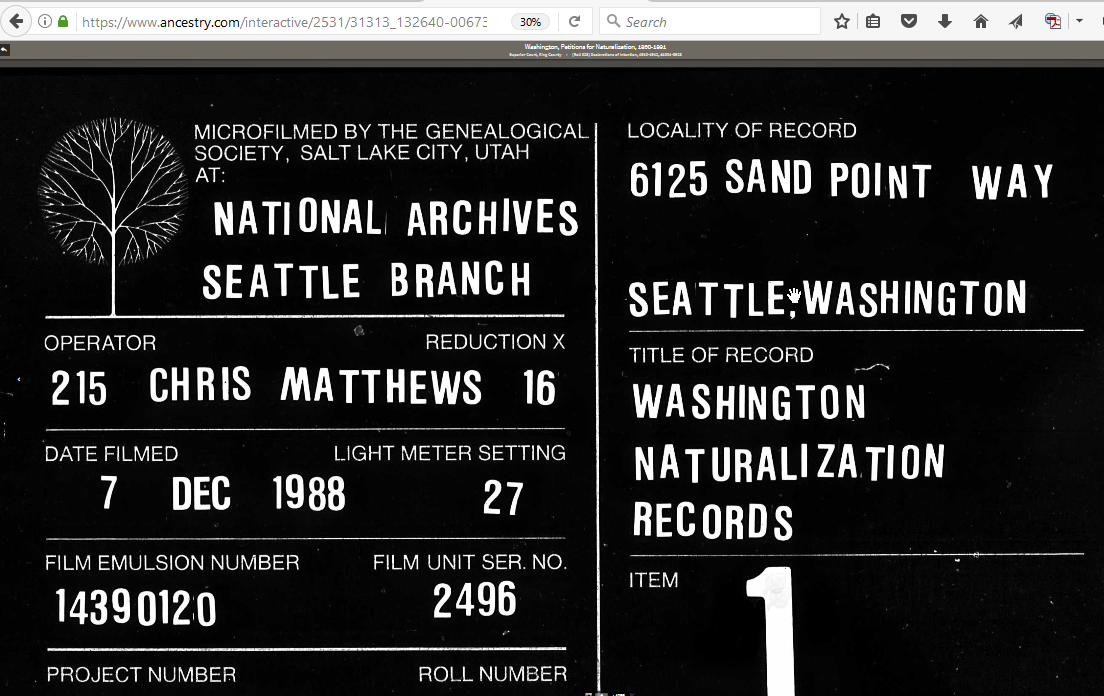Forums
I would like to cite a Declaration of Intention (to become a citizen of the USA). What started out seeming like a simple exercise has turned confusing. The declaration I'd like to cite is available at Ancestry and Family Search. Both sources seem to be from the same microfilm, yet the Ancestry copy contains an image which reads "1543, 25" (which is appropriate for the NARA microfilm) that the FamilySearch microfilm lacks.
Is there any reason to prefer one over the other (other than clarity)? Also, should I add more detail to my email reference re. the repository?
One last question. Should I list the Ancestry collection as "database and images" even though I used only the image for my information and only used the database as an index to find the image?
Thank you for your help!
Brian
FamilySearch:
Washington, King County Superior Court, Record of Declaration[s] of Intention 11 (5001 to 5500) : 158, Declaration of Intention no. 5158, Isaac Makynen Matson, 30 June 1911; accessed as "Indexes to naturalization and citizenships, 1865-1928; declarations of intention, 1854-1924; petitions 1906-1921," images, FamilySearch (https://familysearch.org/search/catalog/383247?availability=Family History Library : accessed 18 Apr 2017), > Film/DGS 1602578 > Browse the images online > image 673 of 1098; imaged from Family History Library (FHL) microfilm 1,602,758, item 3; citing "National Archives Branch at Seattle". This microfilm header shows that the microfilm is also National Archives (NARA) microfilm publication M1543, roll 25. Email from the National Archives at Seattle indicates that the original records are now held by the Washington State Archives, Bellevue.
Ancestry:
Washington, King County Superior Court, Record of Declaration[s] of Intention 11 (5001 to 5500) : 158, Declaration of Intention no. 5158, Isaac Makynen Matson, 30 June 1911; accessed as "Washington, Petitions for Naturalization, 1860-1991," images, Ancestry (http://search.ancestry.com/search/db.aspx?dbid=2531 : accessed 18 Apr 2017); imaged from National Archives (NARA) microfilm publication M1543, roll 25; citing "The National Archives at Seattle, Seattle Washingon". The microfilm header shows that the microfilm is also Family Research Library (FHL) microfilm 1,602,758. Email from the National Archives at Seattle indicates that the original records are now held by the Washington State Archives, Bellevue.
Brian
Dear Sharp-eyed Brian,
Dear Sharp-eyed Brian,
Your noticing--and recording--the microfilm publication number and roll number will someday help someone. It's worth recording, along with the context provided by NA-Seattle, even though it makes for a very long citation.
That said, the situation is even more complicated. At the beginning of the roll of film, we see that the film was not created by the National Archives.
.
The film was actually created by the Genealogical Society of Utah, after which it became FHL microfilm 1602578 (see first frame of that roll of film). Because the film was made from records at a National Archives facility, NARA was given a copy--which NARA accessioned (and subsequently distributed) as microfilm publication M1543. If we go to NARA's page for "Search & Browse Microfilm" and query for M1543 the result (http://bit.ly/1llliSO) confirms that NARA offers the GSU/FHL film as a film publication. But, still, the creator is GSU--which is why GSU's "library arm" FHL is not citing the NARA microfilm publication number.
Brian, you also asked:
Brian, you also asked:
Should I list the Ancestry collection as "database and images" even though I used only the image for my information and only used the database as an index to find the image?
Databases have become much more complicated, too. Many (if not most) of those we are now consulting for historical research do hold images as well as words typed into data fields. EE now uses the term "database with images" as an identifier in that citation field, right after the title, where we put edition ID (for books) or publication type (for online sources).
Past that point,
Thank you for the information
Thank you for the information (and the provenance of the NARA microfilm).
Yes, this was an unusual record! Not only were the sources confusing, but the fact that NARA had cataloged (and had a microfilm of) county, not national, records was a surprise. (These county records were created, of course, because federal law was written that way at the time.)
For some time I've wondered about the information in FHL microfilm headers. That information details where the filming took place, but aren't proof that the records were stored or are still stored where the filming took place. I rarely try to chase down the current location of original records from FHL microfilm, but this situation (county records seemingly stored at the NA) begged for clarification!
Thank you again,
Brian
That fact that county-level
That fact that county-level records were in a NARA facility caught my eye as well--and prompted me to probe deeper. NARA does hold some strange things. For example,who would expect NARA to hold photostats of the church registers of colonial Spanish St. Augustine? Yet, they're there--as a special gift.
In the case you uncovered, it is not illogical for naturalization records of King County to be there at NA-Seattle. Many county courthouse, as they run out of space, have deposited records in other archives. Usually it's in the state archives or a county archives or local library or university archives. In this case, given that the records deal with naturalizations, which became a federal function, and given that there is a federal archives branch nearby, it's actually logical that they would be placed there.